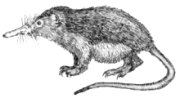 The shrewlike Cuban Solenodon (Solenodon cubanus) has short legs and it possesses skin glands that produce a goat-like smell. Its elongated head has tiny eyes coupled with a flexible snout. Their fur could be any of the following: black, red-brown or dark brown. They could be found in both forests and scrublands, and in the main, they are terrestrial. However, the Cuban Solenodons have the ability to climb. At the ground level, they move with an unsteady gait, but for short lengths, a Cuban Solenodon could run quickly.
The shrewlike Cuban Solenodon (Solenodon cubanus) has short legs and it possesses skin glands that produce a goat-like smell. Its elongated head has tiny eyes coupled with a flexible snout. Their fur could be any of the following: black, red-brown or dark brown. They could be found in both forests and scrublands, and in the main, they are terrestrial. However, the Cuban Solenodons have the ability to climb. At the ground level, they move with an unsteady gait, but for short lengths, a Cuban Solenodon could run quickly.At night when they are foraging for food, they use that snout to tear tree trunks. Their diet also consists of snakes, frogs, and crabs. A Cuban Solenodon is basically social, with many members residing in a single hole (burrow that is). A Cuban Solenodon communicates with others via squeaks, squeals and twitters. They comprise the family Solenodontidae, and this in turn belongs to a set of mammals termed as insectivores by the scientific community.
Wilhelm Peters discovered this breed of solenodons in 1861. By 1970, everybody thought they had gone extinct. Wrong, three individual solenodons were caught in the mid-70s. Still, they are rare in any part of the globe they exist in. Before 2003, the last sighting came in '99 and no wonder- they are night burrowers and they live in the basement, so to speak.
Interesting fact: The solenodon adults approach one another with their mouths open, probably giving out high-frequency sounds.
The Almiqui, cuban solenodon is listed as Endangered (EN), considered to be facing a very high risk of extinction in the wild, on the IUCN Red List of Threatened Species
Cuban solenodon habitats
Artificial / Terrestrial, Caves, Caves and Subterranean Habitats (non-aquatic), Forest, Plantations and Subtropical / Tropical Dry forest
Custom Search